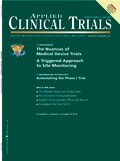Foreign Clinical Trials Under Scrutiny
Applied Clinical Trials
Inspector General study focuses attention on quality of data and patient safeguards.

More clinical trials are being conducted outside the United States, creating challenges for the Food and Drug Administration as well as for sponsors. The Office of the Inspector General (OIG) of the Department of Health and Human Services (HHS) issued a report in June urging increased oversight of study results obtained from other regions to protect patients and ensure data integrity. The third in a series of analyses on this topic over the past decade, this investigation has produced a fairly mild report. Most of its recommendations already are being implemented by FDA or are on the agency's wish list, such as inspecting more sites and requiring standardized electronic data.
The interest generated by the report, however, reflects continued public concern about how relevant foreign studies are in supporting approval of new drugs for U.S. patients, and whether pharma companies are going overseas largely to cut costs and avoid strict oversight. There are questions about adherence to good clinical practices (GCPs) by foreign investigators and if regulatory authorities and institutional review boards in developing nations have the capacity and resources to fully monitor research activities.
Pharmaceutical companies acknowledge that foreign trials generally are less costly. But they maintain that their real incentive for going global is to gain access to larger numbers of treatment naïve patients, to be able to accelerate time of accrual, and to develop products that are safe and effective for patients in all regions of the world.
Under the International Conference on Harmonization (ICH), industry and regulators have promoted broader acceptance of study data from foreign sites to speed new therapies to patients and to avoid duplicative trials, which may be unethical if they impose unnecessary risks on patients. The ICH E5 standard adopted in 1998 established a framework for evaluating ethnic factors affecting the acceptance of safety and efficacy studies and clarified where "bridging studies" could help determine when data generated in one region is acceptable to a population elsewhere.
At the DIA Annual Meeting in June, Murray Lumpkin, FDA deputy commissioner for international programs, pointed out that the onus is on the sponsor to make the case that foreign clinical data is valid, is complete, and is able to predict the utility of the product in the U.S. population and the U.S. medical system. Determining the relevance of data from a foreign population, Lumpkin explained, involves assessing appropriate primary endpoints, underlying illnesses, concomitant therapies, and cultural issues such as diet and popular herbal remedies.
The OIG report on "Challenges to FDA's Ability to Monitor and Inspect Foreign Clinical Trials" (OEI-01-08-00510) documents the rise in foreign studies by analyzing all marketing applications for drugs and biologics approved in fiscal year 2008. It found that 80% contain data from foreign trials and over half of study subjects and sites were located outside the United States. But most of those foreign sites (about 60%) were in Western Europe, namely Germany, France, and other nations not known for lax regulation.
FDA has no specific minimum on the number or proportion of patients studied in the United States for a given development project; U.S. regulations even permit sponsors to submit marketing applications with data exclusively from foreign studies. Those studies, moreover, do not have to be conducted under an IND (investigational new drug application), although they do have to comply with GCPs. So far, FDA says in its comments on the report, that it has not observed "distinct differences in non-compliance with FDA regulations" from domestic vs. international inspections, but will continue to assess trends in data integrity and human subject protections revealed through its GCP program.
More INDs?
A specific OIG concern is the growing number of foreign trials that are not conducted under an IND, but used later to support market applications in the United States. In 2008, sponsors filed 10 applications containing only foreign data, making it difficult for FDA to review the study protocol or to monitor the research program while it is ongoing. The OIG wants FDA to examine whether such trials might compromise "the rights, safety, and well-being of subjects or the integrity of the data submitted by sponsors."
Under current law, though, FDA cannot require sponsors to file an IND for studies conducted outside the United States. One response by the agency is to do more to help foreign regulators improve their oversight capacity. In addition, FDA is exploring ways to track the number of applications submitted with clinical data collected outside the IND rules, possibly from the ClinicalTrials.gov database or from international clinical trial registries being developed by the European Medicines Agency (EMA) and the World Health Organization.
Many of the non-IND foreign studies involve early-stage clinical trials, but FDA is skeptical about conducting more inspections in this area. FDA audits a few early phase studies, primarily those involving cellular or gene therapies, pediatric studies or other research that carries particularly high risks. The Center for Drug Evaluation and Research (CDER) is initiating routine inspections of earlier phase studies in the United States this year, and will assess whether other regulatory authorities are taking similar steps.
More oversight
Overall, FDA inspects very few clinical studies, only 1.2% of all clinical sites in 2008, according to the OIG, and more than twice as many domestic than foreign sites. The OIG would like FDA to increase its overseas audits, particularly in those countries that have only recently adopted GCPs.
At the DIA meeting, Leslie Ball, Director of the Division of Scientific Investigations (DSI) in CDER, noted that the OIG report may prompt FDA to look more critically at the quality of data that comes from non-U.S. studies and at its applicability to domestic approvals. She explained that the agency's evaluation of foreign data depends on the type of patient population studied and disease state, as well as relevant cultural and ethnic factors. Ball noted that CDER has been examining the growing number of applications that have data only from outside the United States, and that this "might result in some additional analysis and soul-searching about whether or not requirements [on minimum U.S. data] need to be put in place."
FDA also is piloting a risk-based model for selecting sites for inspection, something else that the OIG recommends (see View from Washington, June 2010). In the past, FDA typically visited the highest enrolling sites, but now is looking at a number of parameters in scheduling inspections. A trial's geographic location is one factor that could trigger an audit, along with study design, type of application, number and type of subjects, previous regulatory violations, serious adverse event rate, and dropout history.
"We expect this to be more complex and less predictable about where DSI will go," Ball commented. And just when the regulated community thinks it knows the agency's risk algorithm, "we will change it," she said, in order to encourage quality research at every site. FDA also plans more inspections of sponsors and contract research organizations to examine their roles in ensuring quality across many trial sites.
The development of a database on clinical trials would help FDA select sites for inspection and could be established more easily if sponsors submitted clinical data in a standard electronic format, a high priority for both FDA and the investigators.
The OIG analysis found that most clinical study reports are filed in inconsistent PDF formats, making it very hard to analyze and compare results. FDA has been struggling for years to establish eData submission standards and expects to continue this effort.
Overseas cooperation
FDA also agrees with OIG's enthusiasm for inspectional agreements with foreign regulatory bodies. The report praises FDA's recent Memorandum of Understanding (MOU) with the EMA as a "positive step for the agency to extend its oversight capability outside the U.S." Under this MOU signed in 2009, FDA and EMA are sharing information on inspection plans and results and conducting a number of joint inspection exercises.
FDA signed another MOU in May with the Russian agency that oversees clinical research, which will support GCP adoption and joint workshops. This is part of more extensive FDA outreach and capacity building efforts with foreign regulatory authorities in regions experiencing a growth in clinical research. FDA is working with the Pan American Health Organization (PAHO) to further harmonize GCPs and other drug regulations, a development that reflects a growing number of research sites in Latin America.
Jill Wechsler is the Washington editor of Applied Clinical Trials, (301) 656-4634, [email protected]

FDA Fast Tracks Johnson & Johnson’s Nipocalimab for Fetal Neonatal Alloimmune Thrombocytopenia
March 27th 2024Johnson & Johnson is moving forward with a pair of Phase III trials of nipocalimab to reduce the risk of fetal neonatal alloimmune thrombocytopenia in alloimmunized pregnant patients.